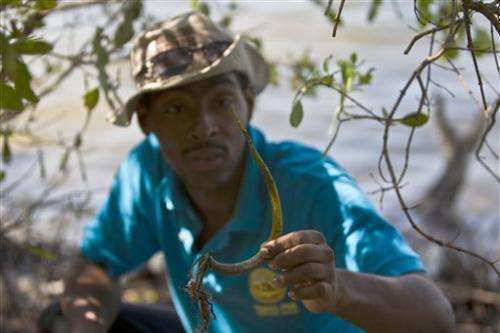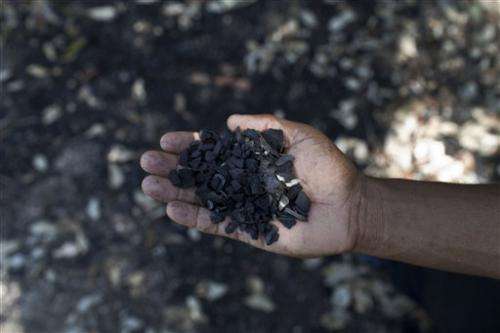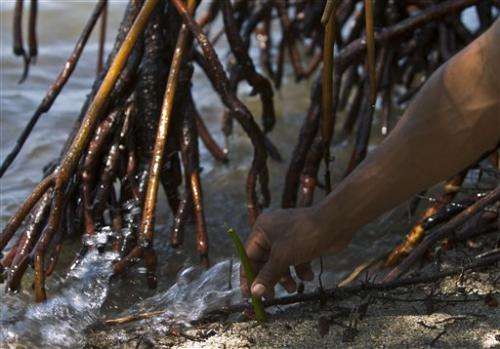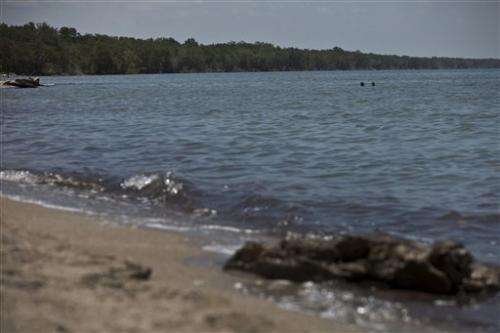Cuba looks to mangroves to fend off rising seas

(AP)—Many people in this tiny hamlet on the southern coast of Cuba remember when the shore lay about 100 meters (yards) farther out. That was four decades ago.
Since then, rising waters have gradually swallowed up rustic homes, a narrow highway that once paralleled the coast, even an old military tank that people now use to measure the sea's yearly advance.
"There was a road there," said Jose Manuel Herrera, 42, a fisherman and former charcoal harvester, pointing toward the gentle waves. "You could travel from here all the way to Mayabeque."
Worried by forecasts of rising seas from climate change, the effects of hurricanes and the salinization of farmlands, authorities say they are beginning a forced march to repair Cuba's first line of defense against the advancing waters—its mangrove thickets, which have been damaged by decades of neglect and uncontrolled logging.
In the second half of 2013, a moratorium was declared on mangrove logging. Now, the final touches are being put on a sustainable management master plan that is expected to be in place before the end of the year. President Raul Castro has said the plan is a top priority.
What makes the effort vital and closely monitored by environmentalists is that Cuba is one of the few places left in the Caribbean with extensive mangrove forests. Cuba accounts for about 69 percent of the region's current mangroves, the New York-based Environmental Defense Fund says. Mangroves act as both a barrier to the sea and a saltwater filter, making them important for coastal health.
Even in Cuba, experts say the situation is critical.
"The situation is bad. More than 30 percent of the mangroves are in a critical state," government forest scientist Reynier Samon said on a recent tour of Surgidero de Batabano, an area where deforestation has been extreme. The rest, he said, are in a state of medium deterioration.
Mangroves historically have been harvested heavily, for textile dyes, tannins used in the pharmaceutical industry, lumber for furniture and charcoal that rural Cubans rely on to fire their kitchens.
But healthy mangrove stands are important to alleviating one of the island's biggest headaches: Rising seas stand to wipe 122 towns off the map and penetrate up to 2 kilometers (1.2 miles) inland in low-lying areas by 2100, posing a serious threat to coastal communities and agriculture, according to a government study last year.

Efrain Arrazcaeta, who runs a local environmental nonprofit, has witnessed the phenomenon with growing alarm. His group estimates a 2-meter (6.6-foot) maritime advance each year, using the submerged tank as a reference point.
"If the mangroves are restored, the mitigation of these effects will be notable," Arrazcaeta said.
No details of the mangrove plan have been made public. It will apparently include sustainable exploitation measures with some logging for the pharmaceutical industry under study, though the moratorium will remain more or less in place.
Officials are also waging a public awareness campaign to educate coastal residents to be caretakers of the tangled, mosquito-infested thickets. The campaign shows them how their own homes and farms are at stake and urges them to protect freshwater streams vital for maintaining the right saline levels.
"The perception of the importance of this ecosystem for these communities is low. They see it as something to exploit," said Samon, the government scientist.
Extensive reforestation isn't easy. There's no way of mechanizing the process, which means brigades of workers will have to wade into the swampy terrain and plant each mangrove by hand.
Even deciding what to plant where requires careful study. Red mangroves thrive next to the sea, black mangroves a few meters (yards) inland, "yana" mangroves beyond that. And if you plant any variety in a place that's too salty or not salty enough, it will die.
Financing for the plan comes from various ministries as well as a U.N. program on climate change adaptation. Officials declined to give budget figures, but said it's in the millions of dollars.

Samon said that in the past year some 36,000 hectares (89,000 acres) of mangroves have been successfully replanted nationwide. The measure complements other programs to relocate coastal buildings, protect sand dunes and regulate how close hotels can be to the sea.
In Surgidero, residents say the logging moratorium and some small initial reforestation have already had a noticeable effect. Seen from the sea, the coastline looks greener, they say.
"There is a cay that formed just from the (new) mangroves and in one year it grew to a good size," said Alexis Duarte, a fisherman.
Studies show that while mangrove loss across the Americas is about 3.6 percent per year, Cuba has recorded net gains in recent years.

Dan Whittle, Cuba program director for the Environmental Defense Fund, said Cuba "is probably the model for other countries" in the region for the coastal protection measures it has taken over the past decade or so.
However, he said, much work remains and Cuba has a mixed record implementing its protective laws and policies.
Samon says the political will is there to address the challenge. "Now we are in the phase of implementation and boots on the ground. It's urgent."
© 2014 The Associated Press. All rights reserved.


















